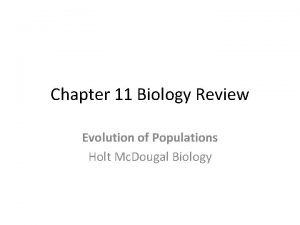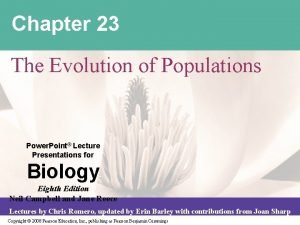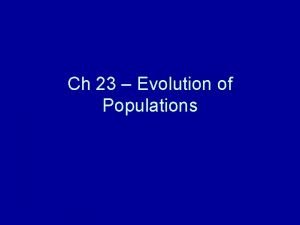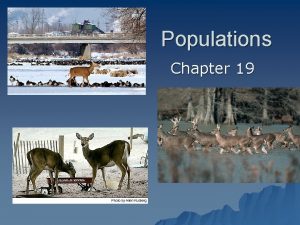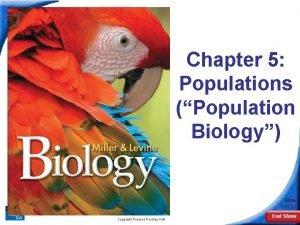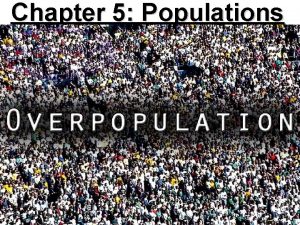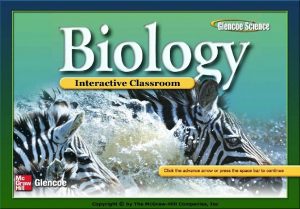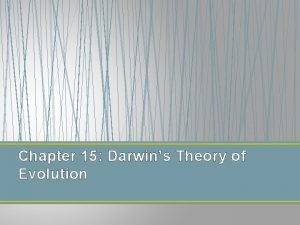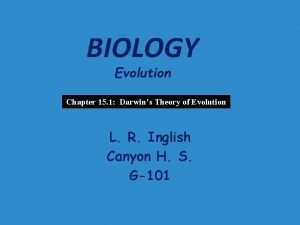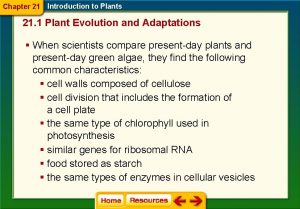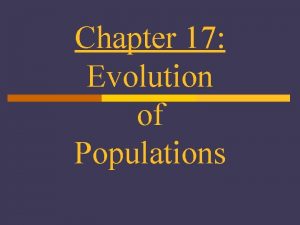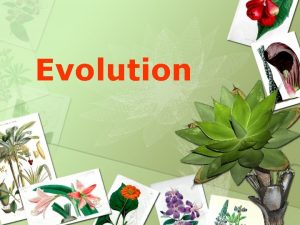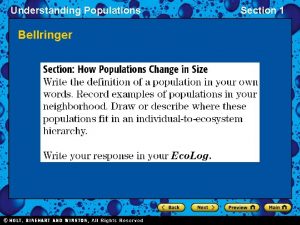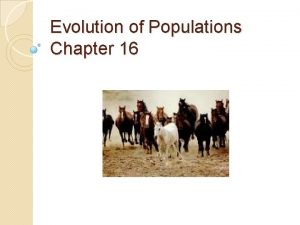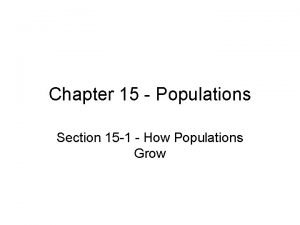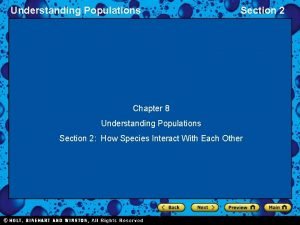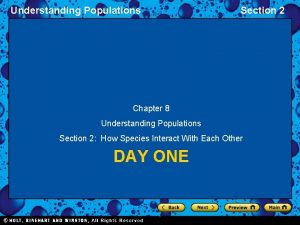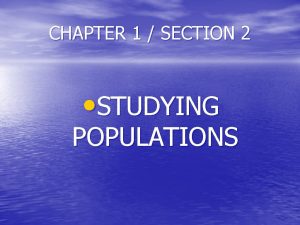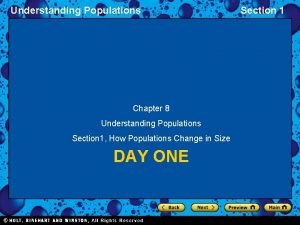Chapter 16 The Evolution of Populations Section 16

















- Slides: 17

Chapter 16: The Evolution of Populations Section 16 -1 Genes and Variation 1. Is the Following sentence true or false? Mendel’s work on inheritance was publish after Darwin’s lifetime. False 2. Which two important factors was Darwin unable to explain without an understanding of heredity? The source of variation and how genes were passed from generation to generation Gregor Mendel 3. List the three fields that collaborate today to explain evolution a. Genetics b. Molecular Biology c. Theory

Gene Pools 4. A collection of individuals of the same species in a given area is a population 5. The combined genetic information of all members of a particular population is a gene pool 6. Is the following statement true or false? A gene pool typically contains just one allele for each inheritable trait False 7. The number of times that an allele occurs in a gene pool compared to the number of times other alleles occur is called the relative frequency

Sources of Genetic Variation 8. Complete the concept map Source of Genetic variation Include Mutations Gene Shuffling 9. What is a mutation? Any Change in the sequence of DNA 10. Why do mutations occur? As a result of mistakes in the replication of the DNA or as a result of radiation or chemicals in the environment

11. Circle the letter that is true about mutations a. They can be limited to a single base of DNA b. They always affect lengthy segments of a chromosome c. They always affect an organism’s phenotype d. They always affect an organism’s fitness 12. Is the following statement true of false? Most inheritable differences are due to gene shuffling that occurs during the production of gametes 13. Circle the letter of each choice that is true of sexual reproduction a. It is a major source of variation in many populations b. It can produce many different phenotypes c. It can produce many different gene combinations d. It can change the relative frequencies of a population

Single- Gene and Polygenetic traits 14. Is the following sentence true or false. ? The number of phenotypes produced for a given trait depends upon how many genes control the trait 15. Is the following sentence true or false? Most traits are controlled by a single gene 16. Label the two graphs to show which one represents a single gene trait and which one represents a polygenetic trait Single gene trait Phenotype (height) Frequency of Phenotype (%) Frequency of Phenotype Polygenetic Trait Widow’s peak No widow’s peak Phenotype

16 -2 Evolution as Genetic Change Natural Selection on Single-Gene Traits 1. Is the following sentence true or false? Natural selection on single gene traits cannot lead to changes in allele frequencies 2. If a trait made an organism less likely to survive and reproduce, what would happen to that trait? Fewer copies would be passed onto the next generation and the trait could, possibly disappear from the gene pool 3. If a trait had no effect on an organism fitness, what would happen to the allele for that trait? The allele and its frequency would remain unchanged

4. List three ways that natural selection can affect the distribution of phenotypes a. Directional Selection b. Stabilizing Selection Match the type of selection with the situation in which it occurs Type of Selection b 5. Directional ____ c 6. Stabilizing ____ a 7. Disruptive ____ Situation c. Disruptive Selection a. Individuals at the upper and lower end of the curve have higher fitness than those in the middle b. B. Individuals at one end of the curve have higher fitness than those at the other end c. Individuals in the middle have the highest fitness

8. An increase in the average size of beaks in Galapagos finches is an example of Directional Selection

9. Is the following sentence true or false? The weight of human infants at birth is under the influence of disruptive selection 10. Draw the missing graph to show disruptive selection affects beak size Disruptive Selection Low mortality, high fitness High mortality, low fitness Beak Size Population splits into two subgroups specializing in different seeds. Number of Birds in Population Key Number of Birds in Population Largest and smallest seeds become more common. Beak Size

Genetic Drift 11. Is the following sentence true or false? Natural selection is the only source of evolutionary change. 12. Random change in allele frequencies in small populations is called Genetic Drift 13. A situation in which allele frequencies change as a result of migration of a small subgroup of a population is called The Founder Effect 14. What is an example of the founder effect? The evolution of the 6 th finger on the hands of the Old Amish people of Pennsylvania

Evolution verses Genetic Equilibrium 15. What does the Hardy Weinberg Principle state? Allele frequency in a population will remain constant unless one or more factors cause them to change 16. The situation in which allele frequencies remain constant is called Genetic Equilibrium 17. The 5 conditions required to maintain genetic equilibrium 18. Why is large population size a. Random mating important in maintaining genetic b. Large population equilibrium? c. No migration d. No mutations e. No natural selection Genetic Drift has less effect on large populations

16 -3 The Process of Speciation What is Speciation? The formation of a new species If two species are reproductively isolated from each other They cannot interbreed and produce offspring What must happen in order for a new species to evolve? Populations must be reproductively isolated from one another

Three ways that reproductive isolation occurs a. Behavioral isolation Species do not interbreed because of different courtship rituals b. Temporal Isolation- organisms interbreed at different times of the day or season Three Similar species of orchids release pollen on different days Behavioral Isolation Eastern and western meadowlark Sing different songs to attract mates

C. Geographic Isolation When populations are separated by geographic barriers, such as mountain ranges, rivers, or oceans Abert and Kaibab Squirrels in the south west are an example of geographic isolation

14. Circle the letter of each Observation that was made by the Grants a. Differences in beak size were more important for survival during the wet season b. When food for finches was scarce, individuals with the largest beaks were less likely to survive c. Big beaked birds tended to mate with small beaked birds d. Average beak size increased dramatically

15. Complete the flowchart to show speciation probably occurred in the Galapagos finches Founders arrive Separation of species Changes in gene pool Reproductive Isolation Ecological Competition Continued Evolution 16. How could difference in beak size lead to reproductive isolation? Birds with the same beak size mated. Birds of different beak size did NOT mate and the gene pools of the different beak sized birds remained isolated. 17. Is the following sentence true or false? During the dry season individual birds that are most different from each other have the highest fitness

Concept Map Reproductive Isolation results from Isolating mechanisms which include Behavioral isolation Geographic isolation Temporal isolation produced by Behavioral differences Physical separation Different mating times which result in Independently evolving populations which result in Formation of new species
 Evolution of populations section 16-1 genes and variation
Evolution of populations section 16-1 genes and variation Evolution of populations section 16-1 genes and variation
Evolution of populations section 16-1 genes and variation Evolution of populations section 11 review
Evolution of populations section 11 review Chapter 16 evolution of populations vocabulary review
Chapter 16 evolution of populations vocabulary review Chapter 17 evolution of populations answer key
Chapter 17 evolution of populations answer key Chapter 23: the evolution of populations
Chapter 23: the evolution of populations Chapter 16 evolution of populations
Chapter 16 evolution of populations Chapter 23 the evolution of populations
Chapter 23 the evolution of populations Why are populations the smallest unit of evolution
Why are populations the smallest unit of evolution Section 19-1 understanding populations answer key
Section 19-1 understanding populations answer key Population growth concept map
Population growth concept map Section 5-1 how populations grow
Section 5-1 how populations grow Section 5-1 how populations grow
Section 5-1 how populations grow Chapter 15 darwin's theory of evolution section 15-1
Chapter 15 darwin's theory of evolution section 15-1 Chapter 21 section 1 plant evolution and adaptations
Chapter 21 section 1 plant evolution and adaptations Chapter 15 darwin's theory of evolution section review 15-1
Chapter 15 darwin's theory of evolution section review 15-1 Homologous structures definition biology
Homologous structures definition biology Chapter 21 section 1 plant evolution and adaptations
Chapter 21 section 1 plant evolution and adaptations


